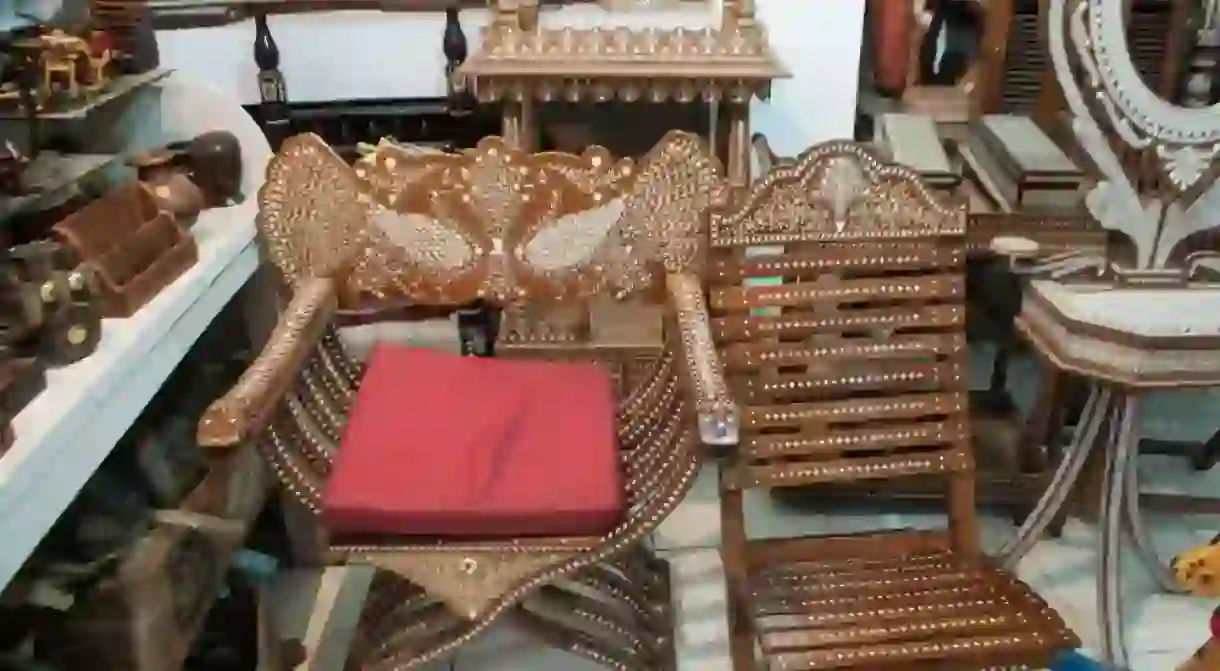Stunning Wood Art From Hoshiarpur In Punjab

What does the funnily named ‘Dabbi Bazar’ bring to mind? It has the most delicately carved incredible treasures in-store. Although it’s just a narrow lane, it is full of beautiful and exquisite wood art on display.
Hoshiarpur, a bustling town with lush green fields, lies in the northeastern part of the colorful Indian state of Punjab and is famously known as the ‘city of mangoes.’ It is located in the foothills of the Himalayas, in the lower Shivaliks, and shares boundaries with two districts of Himachal Pradesh.

What exactly is the art of wood inlay craft?
Wood inlay craft originated in Hoshiarpur about 300 years ago, and ivory was originally used until it was banned altogether in 1989. Farmers in their off-season experimented with this art due to seasonal work of farming, and in due course of time, they became masters at it. Various products such as inlaid tables, chairs, screens, chest boxes, corners, chess boards, jewelry boxes, trays, elephants and trolleys and other items of use in everyday life are spotted in Dabbi Bazaar. The artists became so skillful that many of them were recognized by the kings and have been subsequently awarded by the Government of India.

The wood of the shisham tree, which is of a very high quality, is normally used in this wood art of Hoshiarpur. Teak and rosewood are also used in some products.

When you enter, your eyes will wander around the shop, amazed with the carvings and various paintings. The shopkeepers are friendly and will guide you to the workshops when they realize that you’re interested in learning more about the products and the craft.
In simple words, inlay is a technique of inserting pieces of contrasting colors into hollowed out spaces to form a design. It involves engraving foliage patterns, and simple everyday designs are inlaid with either acrylic, plastic, bronze or camel bone.

The first step is the tracing of designs. For tracing, the pattern to be inlaid is first drawn on a piece of paper. This pattern can be of floral or geometrical designs or traditional motifs. After that, the drawn pattern is traced on both the wood and acrylic sheet using ink. After the patterns have been drawn, the wood is ready for the second step called etching, which is done with the aid of sharp knives and chisels. This leads to the creation of grooves or gaps in the wood. Mostly, the grooves of two to three millimeters deep are created, and the piece is then ready for inlay.
The next and most crucial of all the steps is setting and subsequently pasting of acrylic pieces inside the gaps made in the wood. After creating grooves in the wood, the artisan cuts the acrylic sheet with sharp knives on the traced patterns. Now these small pieces of acrylic are set in the grooves inside the wood, and each piece is carefully glued to the wood. The piece to be inlaid is smoothened with sandpaper and polished in lac. Ideally, the piece is covered with two or three layers of lac and is given a matte or glazed finish as per the client’s requirement, which is the final stage of finishing.
The procedure of wood inlay or Bharai (in Hindi) is not written down anywhere but is passed from one generation to the next. This art is on the wane for lack of awareness.
Sometimes, the final selling price of a particular piece might be able to be negotiated over some Punjabi hospitality and tea and samosas. However, keep in mind the painstaking and time-consuming work that goes into each piece. They’re worth it.

The wood products of Hoshiarpur keep popping up in the news, courtesy of auctions by reputed houses, even though the sale and purchase of ivory in any form has been banned by most governments across the world. The famous Albert Hall museum in Jaipur also houses some rare ivory inlay treasures of Hoshiarpur from the 19th century.
Gaze at the fine details of the 12-kilo table below.

How to reach Hoshiarpur:
By Air: Amritsar, the nearest airport, is 125 kilometers away.
By Rail: Direct trains from Delhi to Hoshiarpur
By Road: Hoshiarpur has excellent road connectivity with Punjab, Himachal Pradesh and Jammu & Kashmir; it can be accessed via NH1 from Delhi.
By Shubham Mansingka













